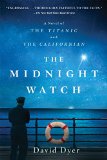Summary | Excerpt | Reading Guide | Reviews | Beyond the Book | Read-Alikes | Genres & Themes | Author Bio

A Novel of the Titanic and the Californian
by David DyerThis article relates to The Midnight Watch
Could the tragedy of the RMS Titanic that unfolded on 15 April 1912, have been prevented or the casualty toll severely decreased? This is the question that anchors The Midnight Watch. The SS Californian, which left Liverpool and was headed for Boston with cargo, was in close enough range of the Titanic for some kind of rescue operation to have been carried out but that never happened. The captain of the ship, Stanley Lord, was widely vilified in the press and in congressional hearings but the verdict remains open about exactly could have been done and to what extent.
 Both the Titanic and the Californian were navigating an ice field the day of the tragedy and as it happens, Captain Lord, finding the ship close to a treacherous area, decided to turn off the motors and hunker down for the night. Reports indicate that wireless messages were transmitted to that effect to area ships including the Titanic and the Antillian.
Both the Titanic and the Californian were navigating an ice field the day of the tragedy and as it happens, Captain Lord, finding the ship close to a treacherous area, decided to turn off the motors and hunker down for the night. Reports indicate that wireless messages were transmitted to that effect to area ships including the Titanic and the Antillian.
One of the points of contention here is that the Titanic launched distress signals but that the Californian did nothing and stood by as close to 1,500 perished in the ice-cold waters. While the truth of what went down is open to interpretation, experts insist that the personnel on board the Titanic did not follow the code of international maritime distress signals. As per the 1912 International Rules of the Road governing Signals of Distress: Article 31: Class 1, called for - a cannon or explosive device [with report] fired at one-minute intervals. The device's report was the sound of distress. Additionally, Article 31: Class 3, covered the sight of distress which is a rocket of any color fired one at a time at short intervals.
While the Titanic did fire rocket signals, they did not follow protocol to signify distress. Over the course of one hour, eight rockets were sent up but not at the time intervals agreed upon by international procedures. The sequence of rockets firing was so random that they could have been interpreted, as per code, as: "This is my position. I am having a navigation problem, please stand clear."
This was one factor that might have contributed to missed opportunities for rescue even if it is unclear exactly how and how much the Californian could have helped. Equally at issue was the fact that the Californian turned off all radio communications for the night while hunkering down and therefore missed radio distress signals relayed by the Titanic.
These mishaps lead to legislation: The Radio Act of 1912 expressly called for radio communications on passenger ships to be operational 24 hours a day, with a secondary power supply, so as not to miss distress calls. The law also called for all ships to be in radio contact with vessels in their vicinity as well as with bases on shore. Although Mayday radio signals are more commonly used these days, sending out distress rockets is still a procedure for ships in trouble, although according to the commonly agreed upon International Convention for the Safety of Life at Sea, only red rockets are to be used in such instances.
Picture of the SS Californian from maritimequest.com
Filed under Cultural Curiosities
![]() This "beyond the book article" relates to The Midnight Watch. It originally ran in April 2016 and has been updated for the
April 2017 paperback edition.
Go to magazine.
This "beyond the book article" relates to The Midnight Watch. It originally ran in April 2016 and has been updated for the
April 2017 paperback edition.
Go to magazine.
Your guide toexceptional books
BookBrowse seeks out and recommends the best in contemporary fiction and nonfiction—books that not only engage and entertain but also deepen our understanding of ourselves and the world around us.